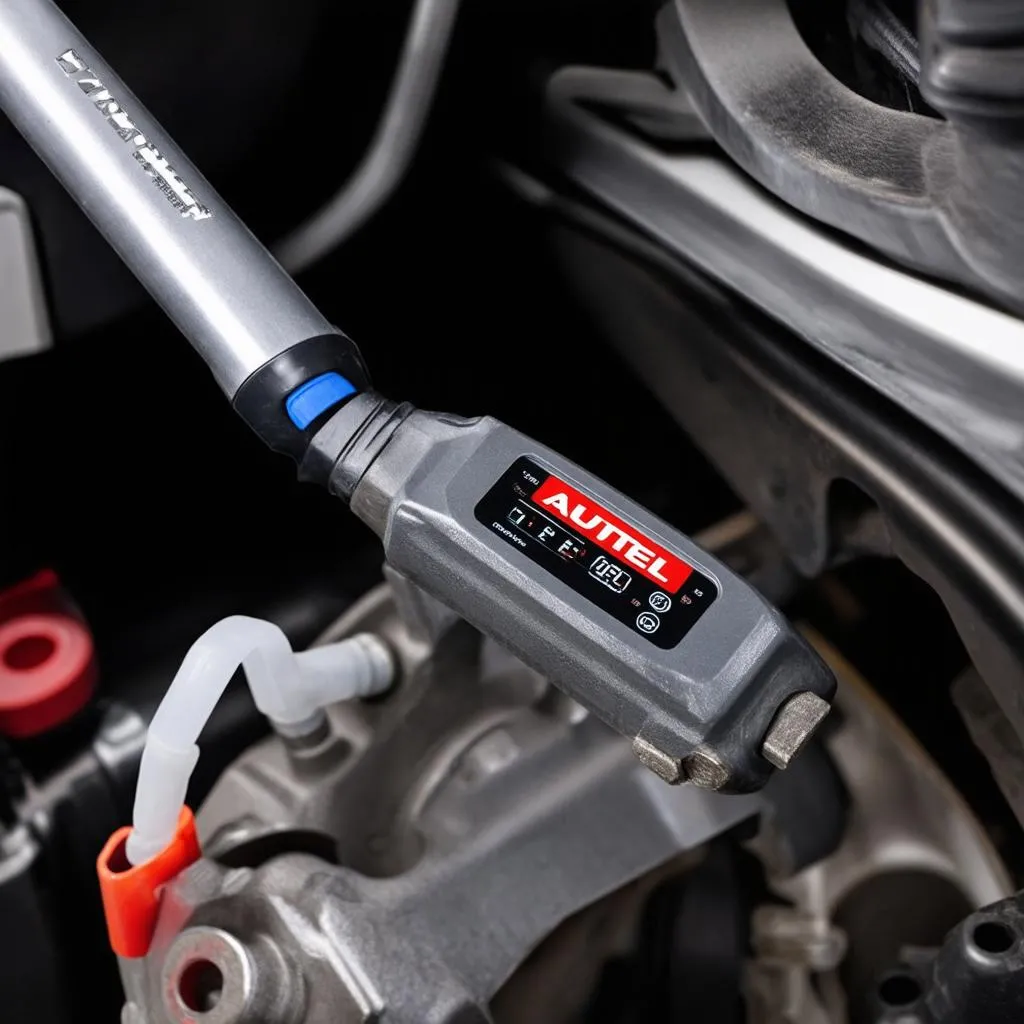Have you ever encountered a spongy brake pedal or a brake system that doesn’t feel right? Maybe you’ve heard whispers about “brake bleeding” and how it can fix those issues, but you’re not sure what it entails or how to do it. Let’s dive into the world of brake bleeding and see how Autel tools can help you tackle this common automotive task.
Understanding Brake Bleeding: A Vital Process for Safety
Brake bleeding is essentially the process of removing air from your brake lines. Air in the brake system can hinder the flow of brake fluid, leading to a spongy brake pedal, delayed response, or even complete brake failure. Think of it as a critical part of maintaining the lifeblood of your braking system.
Why Autel? Powering Up Your Brake Bleeding Process
Autel has become a trusted name in the automotive diagnostic and repair world. Their tools, especially the Autel scanner for European cars, are designed to assist technicians and DIY enthusiasts alike in tackling a wide range of tasks, including brake bleeding.
Diving Deeper: Autel Brake Bleeding Tools and Their Benefits
1. Autel MaxiCheck MX808: Your One-Stop Shop
The MX808 is a versatile tool that can perform brake bleeding along with various other diagnostics. Its intuitive interface and comprehensive capabilities make it a popular choice for home mechanics and professional workshops.
2. Autel MaxiSys: For Comprehensive Diagnostics and Repair
The MaxiSys line offers more advanced functionalities, including in-depth diagnostics, code reading, and brake bleeding capabilities. It’s ideal for those who want a robust solution for a wider range of automotive repairs.
3. Autel EBS301: A Dedicated Solution for Brake Bleeding
For dedicated brake bleeding, the EBS301 is a specialized tool designed to simplify the process. It offers clear instructions, precise control, and efficient bleeding.
Mastering the Art of Brake Bleeding with Autel: A Step-by-Step Guide
1. Gather Your Tools:
- Autel Brake Bleeding Tool (choose the best one for your needs)
- Fresh Brake Fluid (compatible with your vehicle)
- A Clear Container (to catch the old fluid)
- A Few Rags (for cleaning up spills)
2. Locate the Bleeder Valves:
- These valves are usually located on the brake calipers at each wheel. They are often small, with a square or hexagonal opening.
3. Connect the Autel Tool:
- Follow the manufacturer’s instructions to connect the tool to your vehicle’s brake system and select the appropriate bleeding mode.
4. Start the Bleeding Process:
- Use the Autel tool to control the bleeding process, ensuring that the brake fluid reservoir remains full.
5. Test and Repeat:
- Once the bleeding is complete, test the brakes carefully. If the pedal still feels spongy, you may need to repeat the process.
6. Safety First:
- Always exercise caution while working on your brakes. Wear safety glasses to protect your eyes and be mindful of any potential hazards.
Troubleshooting Common Brake Bleeding Issues
- Spongy Pedal: This could indicate air trapped in the lines or a low fluid level. Recheck the bleeding process and ensure the reservoir is full.
- Hard Pedal: This could mean the brake fluid is too old or the system is restricted. Use fresh fluid and inspect the lines for blockages.
Frequently Asked Questions
Q: How often should I bleed my brakes?
A: Brake bleeding is typically recommended every two years or when you notice a spongy brake pedal or other brake issues.
Q: Can I bleed my own brakes?
A: Yes, you can bleed your own brakes if you feel comfortable working on your car. However, it’s always best to consult with a professional if you are unsure.
Q: What type of brake fluid should I use?
A: The type of brake fluid you need will depend on your specific vehicle. Check your owner’s manual or consult with a mechanic.
Q: What are the signs of a brake fluid leak?
A: A brake fluid leak can result in a low fluid level, a soft brake pedal, a grinding noise when braking, or even brake failure.
Q: What if I accidentally put air in my brake lines?
A: Don’t worry, it’s a common mistake. Simply repeat the bleeding process, ensuring all the air is purged from the system.
Conclusion
Brake bleeding is a critical maintenance procedure that ensures safe and reliable braking. Autel tools provide the technology and expertise to help you tackle this task with confidence. Whether you’re a seasoned mechanic or a DIY enthusiast, the right Autel tool can make the process efficient, accurate, and safe. Remember, a well-maintained braking system is crucial for your safety on the road.
Need help with your Autel brake bleeding tool? Contact us via Whatsapp: +84767531508. We have experts available 24/7 to assist you.
Want to learn more about other Autel products? Explore our website for more insights and expert advice:
- Which Autel Do Brake Bleeding?
- Does the Autel MaxiCheck MX808 Do Brake Bleeding?
- Autel MaxiSys Brake Bleeding
- Autel Maxi-Check Scanner for Brake Bleeding
- Autel EBS301 Manual
Share your thoughts and experiences with brake bleeding in the comments below!


